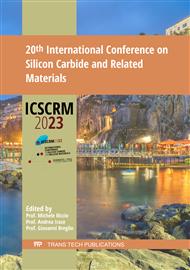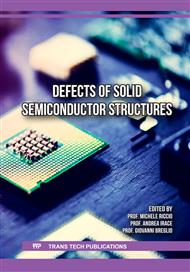[1]
J. Guo, Y. Yang, B. Raghothamachar, T. Kim, M. Dudley, J. Kim, J. Cryst. Growth 480 (2017) 119-125.
Google Scholar
[2]
T. Liu, S. Hu, J. Wang, G. Guo, J. Luo, Y. Wang, J. Guo and Y. Huo, IEEE Access, 7 145118-145123. (2019)
DOI: 10.1109/access.2019.2944991
Google Scholar
[3]
P. Thieberger, C. Carlson, D. Steski, R. Ghandi, A. Bolotnikov, D. Lilienfeld, P. Losee, Nucl. Instrum. Methods Phys. Res. B: Beam Interact. Mater. At. 442 36-40. (2019)
DOI: 10.1016/j.nimb.2019.01.016
Google Scholar
[4]
R. Ghandi, C. Hitchcock, S. Kennerly, ECS Transactions 104 67 (2021)
Google Scholar
[5]
R. Ghandi, A. Bolotnikov, S. Kennerly, C. Hitchcock, P.-m. Tang, T.P. Chow, 2020 32nd International Symposium on Power Semiconductor Devices and ICs (ISPSD), IEEE, 126-129 (2020)
DOI: 10.1109/ispsd46842.2020.9170171
Google Scholar
[6]
R. Ghandi, C. Hitchcock, S. Kennerly, M. Torky and T. P. Chow, 2022 International Electron Devices Meeting (IEDM), p.9.1.1-9.1.4 (San Francisco, CA, USA, 2022)
DOI: 10.1109/iedm45625.2022.10019368
Google Scholar
[7]
Z. Chen, H. Peng, Y. Liu, Q. Cheng, S. Hu, B. Raghothamachar, M. Dudley, R. Ghandi, S. Kennerly and P. Thieberger, Materials Science Forum 1062, 361-365 (2022)
DOI: 10.4028/p-m7sftq
Google Scholar
[8]
Z. Chen, Y. Liu, H. Peng, Q. Cheng, S. Hu, B. Raghothamachar, M. Dudley, R. Ghandi, S. Kennerly and P. Thieberger, ECS J. Solid State Sci. Technol. 11 065003 (2022)
DOI: 10.1149/2162-8777/ac7351
Google Scholar
[9]
A. Yu. Kuznetsov, J. Wong-Leung, A. Hallen, C. Jagadish, and B. G. Svensson, Journal of Applied Physics 94, 7112 (2003)
Google Scholar
[10]
S. Mancini, S. Jang, Z. Chen, D. Kim, Y. Liu, B. Raghothamachar, M. Kang, A. Agarwal, N. Mahadik, R. Stahlbush, M. Dudley, W. Sung, proceeding of 2022 IEEE International Reliability Physics Symposium (IRPS) (2022)
DOI: 10.1109/irps48227.2022.9764538
Google Scholar
[11]
Z.C. Feng, S.C. Lien, J.H. Zhao, X.W. Sun and W. Lu, Thin Solid Films 516.16 (2008) 5217-5222.
DOI: 10.1016/j.tsf.2007.07.094
Google Scholar
[12]
M. Rawski, J. Żuk, M. Kulik, A. Droździel, L. Lin, S. Prucnal, K. Pyszniak and M. Turek, Proceedings of the VIII International Conference ION (2010)
Google Scholar



